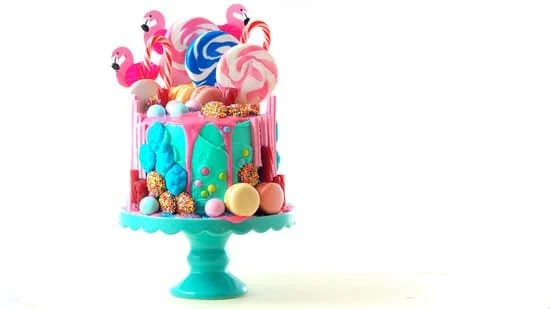Are you ready to learn how to decorate cake using fondant? Fondant cake decorating is a popular technique that allows you to create beautifully sculpted and intricate designs on your cakes. Whether you’re a beginner or looking to improve your skills, this article will guide you through the process of fondant cake decorating, from the tools and materials needed to troubleshooting common issues.
Fondant cake decorating has become increasingly popular for special occasions such as weddings, birthdays, and other celebrations. This versatile sugar paste can be rolled out and shaped to create smooth, flawless finishes or intricate designs, making it the perfect medium for creating custom cakes that stand out at any event.
In this article, we’ll cover everything you need to know about how to work with fondant, including preparing the cake, coloring and flavoring the fondant, applying it to the cake, and using various decorating techniques.
Before diving into the process of working with fondant, it’s essential to gather all the necessary tools and materials. From rolling pins to embossing tools and cutters, having the right equipment will ensure that you can achieve professional-looking results.
Once you have everything you need in place, we’ll walk you through each step of working with fondant, providing tips and tricks along the way to help you avoid common issues and elevate your skills. Whether you’re looking to create simple yet elegant designs or elaborate masterpieces, mastering fondant cake decorating opens up endless creative possibilities for your baking endeavors.
Tools and Materials Needed for Fondant Cake Decorating
When it comes to decorating a cake using fondant, having the right tools and materials is essential for achieving a smooth and professional-looking finish. Here is a list of the basic items you will need to get started with fondant cake decorating:
- Fondant: This is the most important ingredient for decorating cakes with fondant. You can either make your own or purchase pre-made fondant in various colors from baking supply stores.
- Rolling Pin: A long, smooth rolling pin specifically designed for fondant will help you roll out the fondant evenly and smoothly.
- Fondant Smoother: This handy tool is used to gently smooth out any air bubbles and creases in the fondant once it has been applied to the cake.
- Cornstarch or Powdered Sugar: Sprinkling a small amount of cornstarch or powdered sugar on your work surface will prevent the fondant from sticking to it while rolling and shaping.
- Cutting Tools: Sharp knives or pizza cutters are needed for cutting out shapes, trimming excess fondant, and creating intricate designs.
- Embossing Tools: These specialized tools can create textures, patterns, and designs in the fondant to add decorative elements to your cake.
In addition to these basic tools, you may also want to invest in other specialty items such as edible food coloring gels, flavorings, luster dusts, edible glues, and stencils for more advanced decorating techniques. With the right tools and materials at your disposal, you’ll be well on your way to mastering how to decorate a cake using fondant.
Preparing the Cake for Fondant
When it comes to preparing a cake for fondant decoration, the key is to start with a smooth, even surface. Here are some steps to ensure that your cake is ready for fondant application:
1. Level the Cake: Use a long serrated knife or a cake leveler to even out the top of the cake layers. This will ensure that the fondant will lay flat and smooth on top of the cake.
2. Crumb Coat: Before applying fondant, it’s important to cover the cake with a thin layer of buttercream or ganache to seal in any crumbs. This will also help the fondant adhere better to the cake.
3. Chill the Cake: After crumb coating, place the cake in the refrigerator for at least 30 minutes to allow the buttercream or ganache to set. This will make it easier to handle when applying the fondant.
4. Smooth Edges: If necessary, use an offset spatula or bench scraper to smooth out any imperfections on the sides of the cake before covering it with fondant.
By following these steps, you can ensure that your cake is properly prepared for decorating with fondant. With a smooth and even surface, you’ll be ready to take on the next steps in creating a beautifully decorated fondant cake.
Working With Fondant
Rolling Fondant
When rolling out fondant, it’s important to use a clean, smooth surface such as a silicone mat or marble countertop. Sprinkle the surface lightly with powdered sugar to prevent sticking. Use a rolling pin to roll out the fondant into a thin, even layer, turning it frequently to ensure it doesn’t stick to the surface.
Kneading Fondant
Before you start shaping your fondant, you’ll need to knead it until it becomes smooth and pliable. To do this, simply work the fondant in your hands like you would with dough, using gentle pressure to soften it up. Be sure not to over-knead the fondant as this can cause it to become too warm and sticky.
Shaping Fondant
Once your fondant is rolled out and kneaded, you can start shaping it into various decorations for your cake. Use cookie cutters or special fondant shaping tools to create shapes like flowers, leaves, or other decorative elements. You can also use your hands and sculpting tools to mold the fondant into 3D figures or intricate designs.
By mastering these techniques for working with fondant, you’ll be able to create stunning cakes that are sure to impress. With practice and creativity, you can use fondant to bring any cake design idea to life.
Coloring and Flavors for Fondant
When it comes to decorating cakes with fondant, choosing the right colors and flavors can make a significant difference in the overall presentation and taste of the cake. Fondant can be easily customized to match any color scheme or flavor preference, making it a versatile choice for cake decorators.
Coloring fondant is a simple process that allows for endless creative possibilities. To achieve vibrant hues, gel or paste food coloring is recommended over liquid food coloring, as it won’t change the consistency of the fondant. Start by adding a small amount of color using a toothpick and knead the fondant until the color is evenly distributed.
For pastel shades, use less coloring. If you need a larger quantity of fondant in the same color, it’s best to mix all portions together before starting to create an even tone.
In addition to coloring fondant, flavoring it can enhance the overall taste of the cake. While traditional fondant has a subtle vanilla flavor, you can add extracts or oils like almond, lemon, or raspberry to complement the cake’s flavors. When using extracts, start with a small amount and gradually add more until reaching the desired taste.
For added creativity, consider blending different flavors together for a unique and delicious fondant experience. By experimenting with different colors and flavors, decorators can elevate their cakes to new levels of visual appeal and taste sensation using these tips on how to decorate cake using fondant.
Applying Fondant to the Cake
Preparing the Cake Surface
Before applying fondant to a cake, it’s important to prepare the surface properly. Start by covering the cake with a thin layer of buttercream or ganache, also known as crumb coating. This will help the fondant adhere to the cake and create a smooth surface for decorating.
Once the crumb coat has set, roll out the fondant on a clean, non-stick surface using a rolling pin dusted with powdered sugar. The fondant should be rolled to about 1/4 inch thickness or less, depending on personal preference and the design being created. Lift the rolled fondant carefully using a rolling pin for support and drape it over the cake.
Smoothing and Trimming
Gently smooth the fondant over the top and sides of the cake using your hands or a fondant smoother tool. Work from the top down, being careful not to trap air bubbles. Use a sharp knife or pizza cutter to trim away excess fondant around the base of the cake, leaving about an inch of overhang to ensure complete coverage.
Adhering and Finishing
To adhere any decorations or additional pieces of fondant onto the covered cake, use edible glue or water brushed lightly onto the back of each piece. Be sure to work carefully and patiently when applying intricate details. Once all decorations are in place, use a small brush to dust off any excess powdered sugar and give your finished creation one last look over before presenting it.
By following these steps for applying fondant to a cake, you’ll be well on your way to creating beautifully decorated cakes that will wow both family and friends. Whether you’re just starting out or have some experience with fondant decorating, don’t be afraid to experiment with different techniques and designs as you continue honing your craft.
Decorating Techniques With Fondant
Once you have successfully applied the fondant to your cake, it’s time to get creative with decorating techniques. Cutouts, embossing, and ruffles are popular and visually stunning ways to take your fondant cake to the next level.
Using various shaped cutters or even just a sharp knife, you can create intricate designs on your fondant-covered cake. From flowers and leaves to stars and hearts, the possibilities are endless. Simply roll out your colored fondant, press the cutter into the fondant firmly, then carefully lift the cutout and place it onto your cake.
Embossing involves creating a raised or indented design on the fondant using special tools or even everyday items like lace or textured fabric. You can also use embossing mats specifically designed for this purpose. Lightly press the embossing tool into the fondant to create an elegant pattern or texture.
Ruffles add a delicate and feminine touch to any cake design. To create ruffles with fondant, roll out thin strips of fondant using a rolling pin. Then, gently fold and pleat the strips to create a ruffled effect before applying them to the cake in a cascading pattern.
| Technique | Description |
|---|---|
| Cutouts | Create intricate designs using various shaped cutters or a sharp knife. |
| Embossing | Create raised or indented designs on fondant using special tools or everyday items. |
| Ruffles | Create delicate and feminine texture by rolling out thin strips of fondant and then folding them in a pleated pattern. |
Troubleshooting Common Fondant Cake Decorating Issues
Decorating a cake using fondant can be a fun and creative process, but it also comes with its own set of challenges. One common issue that decorators face is air bubbles forming under the fondant as it is applied to the cake.
To prevent this, one tip is to roll the fondant out evenly and make sure to smooth it down onto the cake gently, starting from the top and working your way down the sides. If air bubbles do appear, use a small pin to gently poke a hole in the fondant and then smooth it back down.
Another common problem when working with fondant is sticking, tearing, or cracking. This can happen if the fondant is too dry or if the surface of the cake has not been properly prepared. To avoid this, make sure to lightly coat the surface of the cake with a thin layer of buttercream or apricot glaze before applying the fondant. Additionally, kneading the fondant well before rolling it out can help improve its elasticity and prevent tearing.
One more issue that decorators may encounter is elephant skin, which occurs when the surface of the fondant becomes wrinkled or textured. To fix this problem, try smoothing it out with your hands or a fondant smoother while being careful not to stretch or distort the shape of the fondant. It’s also important to ensure that you are working with fresh fondant that has not dried out.
Overall, troubleshooting common issues when decorating cakes with fondant requires patience and practice. By following these tips and being attentive to detail, you can achieve beautifully decorated cakes using this versatile decorating medium.
Advanced Fondant Cake Decorating Tips and Ideas
For those who have mastered the basics of fondant cake decorating and are looking to take their skills to the next level, there are several advanced tips and ideas to consider. One advanced technique is creating intricate 3D fondant decorations, such as flowers, figurines, or geometric shapes. These decorations add a wow factor to any cake and require a steady hand and attention to detail.
Another advanced tip is mastering the art of painting on fondant using food coloring or edible luster dust. This allows for endless creative possibilities and can elevate the design of a cake.
In addition to mastering more complex decorations, advanced fondant cake decorators may also want to experiment with different flavors and fillings for their cakes. Infusing the fondant with different flavors such as citrus, almond, or coffee can add an extra layer of taste to the overall cake experience. Furthermore, incorporating various textures into the design, such as using edible metallic paint or adding edible glitter to the fondant, can create a visually stunning and unique masterpiece.
Finally, one advanced idea for fondant cake decorating is incorporating mixed media elements into the design. This could include combining fondant with other edible materials like chocolate or isomalt sugar to create a show-stopping dessert centerpiece. Additionally, exploring unconventional shapes and structures for the cake itself can push the boundaries of traditional cake decorating and result in truly extraordinary creations.
By applying these advanced tips and ideas, experienced fondant cake decorators can continue to expand their skill set and create dazzling confections that leave a lasting impression on anyone who sees or tastes them. With practice and creativity, there is no limit to what can be achieved when decorating cakes with fondant.
Conclusion and Resources for Further Learning on Fondant Cake Decorating
In conclusion, decorating cakes using fondant can be a fun and creative way to add a professional touch to your baked goods. While it may seem intimidating at first, with the right tools, materials, and techniques, anyone can master the art of fondant cake decorating. From rolling and shaping the fondant to applying it to the cake and creating intricate designs, there are endless possibilities for creativity.
For those just starting out, it’s important to familiarize yourself with the necessary tools and materials needed for fondant cake decorating. Additionally, learning how to troubleshoot common issues that may arise during the process will help ensure a smooth decorating experience. As you gain more experience and confidence in working with fondant, you can explore advanced techniques and ideas to take your cake decorating skills to the next level.
If you’re interested in furthering your knowledge of fondant cake decorating, there are numerous resources available for additional learning. Whether it’s online tutorials, books, or classes, there are plenty of opportunities to expand your skills and creativity in this art form. With practice and patience, you’ll be able to create stunning cakes that not only look beautiful but also taste delicious. So go ahead and unleash your creativity by learning how to decorate cake using fondant.
Frequently Asked Questions
How Do You Use Fondant on a Cake for Beginners?
Using fondant on a cake for beginners involves rolling out the fondant to the desired thickness, then carefully draping it over the cake. Smooth out any air bubbles and creases, then trim the excess fondant.
How Do You Get Fondant Decorations to Stick to a Cake?
To get fondant decorations to stick to a cake, you can use water, piping gel, or edible glue as an adhesive. Lightly brush the back of the decoration with a small amount of the adhesive and press it onto the cake.
Can You Put Fondant Directly on a Cake?
Yes, you can put fondant directly on a cake. It provides a smooth finish and is often used for intricate designs and decorations. As long as the cake’s surface is clean and free of moisture, the fondant will adhere well to it.

Welcome to our cake decorating blog! My name is Destiny Flores, and I am the proud owner of a cake decorating business named Cake Karma. Our mission is to provide delicious, beautiful cakes for all occasions. We specialize in creating custom cakes that are tailored specifically to each customer’s individual needs and tastes.





